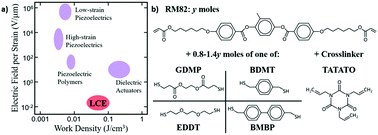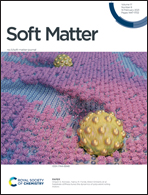Thermomechanically active electrodes power work-dense soft actuators
Abstract
The effect of chain extender structure and composition on the thermomechanical properties of liquid crystal elastomers (LCE) synthesized using thiol–acrylate Michael addition is presented. The intrinsic molecular stiffness of the thiol chain extender and its relative molar ratio to acrylate-based host mesogens determine the magnitudes of the thermomechanical strains, temperatures at which they are realized and the mechanical work-content. A non-linear structure–property relationship emerges, wherein higher concentrations of flexible extenders first magnify the thermomechanical sensitivity, but a continued increase leads to weaker actuation. Understanding this interplay leads to a composite material platform, enabling a peak specific work production of ∼2 J kg−1 using ∼115 mW of electrical power supplied at 2 V. Composites of LCE with eGaIn liquid metal (LM) are prepared, which act as heaters, while being capable of actuation themselves. The thermomechanically active electrodes convert the electrical power into Joule heat, which they efficiently couple with the neat LCE to which they are bound. This system harnesses the nascent responsiveness of the LCE using electrodes that work with them, instead of fighting against them (or passively standing in the way). Specific work generated increases when subjected to increasing levels of load, reaching a peak at loads ∼260× the actuator weight. These ideas are extended to tri-layered actuators, where LCE films with orthogonal molecular orientations sandwich LCE–LM composite heaters. Torsional actuation modes are harnessed to twist under load.



 Please wait while we load your content...
Please wait while we load your content...